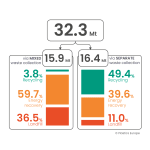
On the pathway to a circular plastics economy
The concept of a circular plastics economy is defined as “a sustainable model where plastics remain in circulation longer, their use is reduced, and they are reused and recycled at the end of their life span.” As noted in the report, this makes it possible to retain the value of plastic waste as a resource while reducing CO2 emissions and preventing plastics from ending up in landfill, being incinerated or polluting the environment, including the oceans. This year’s report discusses in detail the different recycling technologies and the types of plastics made from non-fossil-based feedstock, that is, bio-based plastics, bio-attributed plastics and plastics derived from carbon capture and utilisation.
As previously noted, “circularity is the fastest, most affordable, effective and reliable method for reducing plastics waste and GHG emissions from the plastics system.” The Circular Economy for Plastics: A European Analysis shows that the circular transition of the plastics system accelerated considerably in 2018-2022. This is evidenced, for instance, by the 70% increase in the availability of post-consumer recycled plastics since 2018 (to 6.8 million tonnes in 2022) and by the fact that circular plastics now make up 13.5% (7.3 million tonnes) of all plastic resins converted into new products and components in Europe. As a result, Europe’s plastics system is now more than halfway towards achieving the intermediate goal set out in the Plastics Transition roadmap, which is to use 25 per cent of circular feedstock in new products by 2030. As regards recycled plastics, the recycling rate reached 26.9% (8.7 million tonnes) in 2022. This means that for the first time in history, more plastic waste is recycled than put into landfill, which is an important milestone on the path towards a circular plastics economy in Europe.

Recycling as the main source of circular feedstock
In 2022, European manufacturers relied on a variety of sources of feedstock to produce circular plastics. The main source was mechanical recycling, which accounted for 13.2 per cent of all feedstock, whereas the share of bio-based and chemically recycled plastics was only 1 per cent and 0.1 per cent, respectively. The use of circular plastics also varies between the different target sectors, with the highest demand coming from packaging, building/construction and agriculture. Against that background, other sectors such as automotive and electricals/electronics continue to lag behind.
The report also notes that in order to maximise recycling rates, it is necessary to significantly increase investment in sorting and recycling capacities, including those in chemical recycling. Innovative chemical recycling technologies are needed as a complement to mechanical recycling in order to tap the resource potential of plastic waste, especially the waste that is currently sent to landfill and incineration. Furthermore, improved Extended Producer Responsibility (EPR) schemes and other mandatory measures that incentivise mixed waste sorting also play and will continue to play an important role in increasing separate waste collection. Finally, fostering market demand for recycled plastics is another factor that may play a vital role in encouraging the necessary investment.




